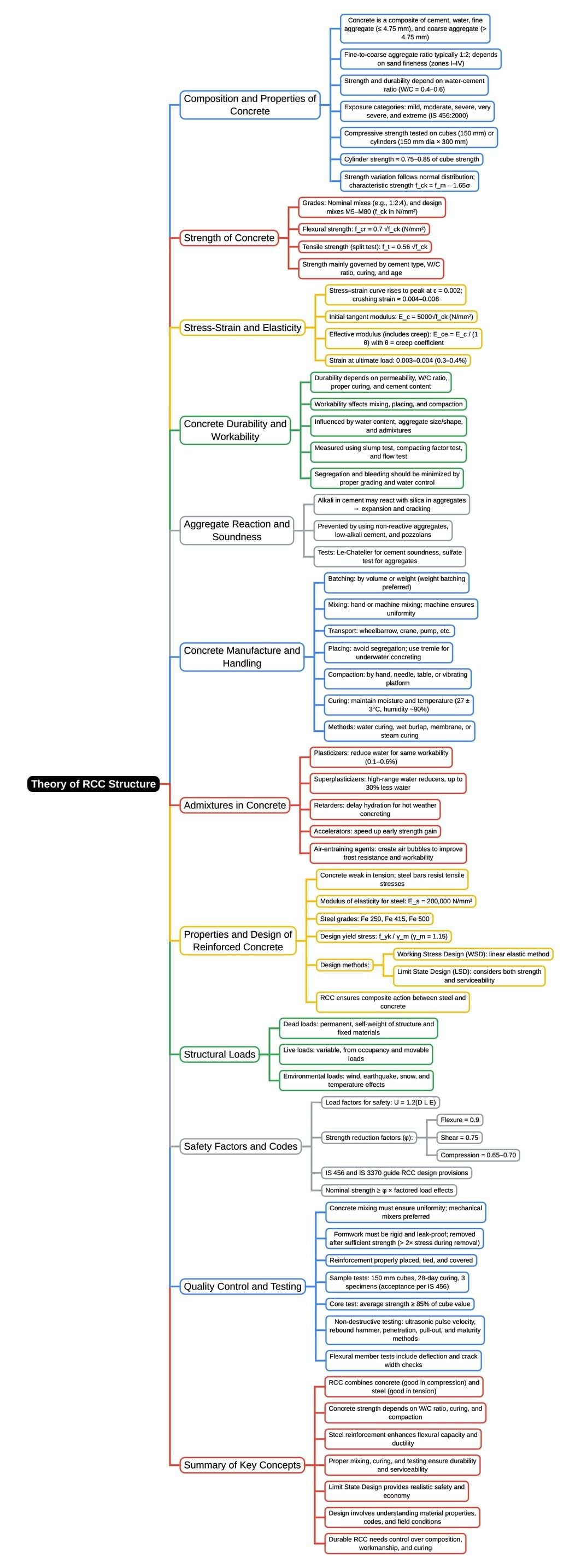Civil Engineering (CE) Exam > Civil Engineering (CE) Notes > RCC & Prestressed Concrete > Mind Map: Theory of RCC Structure
Mind Map: Theory of RCC Structure | RCC & Prestressed Concrete - Civil Engineering (CE) PDF Download

The document Mind Map: Theory of RCC Structure | RCC & Prestressed Concrete - Civil Engineering (CE) is a part of the Civil Engineering (CE) Course RCC & Prestressed Concrete.
All you need of Civil Engineering (CE) at this link: Civil Engineering (CE)
|
13 videos|49 docs|34 tests
|
FAQs on Mind Map: Theory of RCC Structure - RCC & Prestressed Concrete - Civil Engineering (CE)
| 1. What is the significance of Reinforced Cement Concrete (RCC) in modern civil engineering? |  |
Ans. Reinforced Cement Concrete (RCC) is crucial in modern civil engineering as it combines the compressive strength of concrete with the tensile strength of steel reinforcement. This synergy allows for the construction of durable and resilient structures that can withstand various loads and environmental conditions, making RCC a preferred choice for beams, columns, slabs, and foundations.
| 2. How does the design of RCC structures ensure safety and stability? |  |
Ans. The design of RCC structures involves careful consideration of load factors, material strengths, and safety margins. Engineers use principles of structural analysis to determine the forces acting on the structure and ensure that it can resist these forces without failure. Additionally, codes and standards guide the design process to maintain safety and stability throughout the lifespan of the structure.
| 3. What are the common types of loads that RCC structures are designed to support? |  |
Ans. RCC structures are designed to support various types of loads, including dead loads (permanent static loads from the structure itself), live loads (temporary loads from occupancy and use), wind loads (forces due to wind pressure), seismic loads (forces during earthquakes), and snow loads (weight from accumulated snow). Each type of load must be considered in the design to ensure structural integrity.
| 4. What are the typical materials used in the construction of RCC? |  |
Ans. The primary materials used in RCC construction are Portland cement, fine aggregates (sand), coarse aggregates (gravel or crushed stone), and steel reinforcement bars (rebar). These materials are selected based on their properties to ensure the resulting concrete mix achieves the desired strength, workability, and durability.
| 5. What are the advantages of using RCC over traditional construction materials? |  |
Ans. RCC offers several advantages over traditional materials, including high compressive and tensile strength, durability, fire resistance, and versatility in design. It can be molded into various shapes and sizes, making it suitable for a wide range of applications. Additionally, RCC structures can effectively resist environmental elements, reducing maintenance needs over time.
Related Searches
















